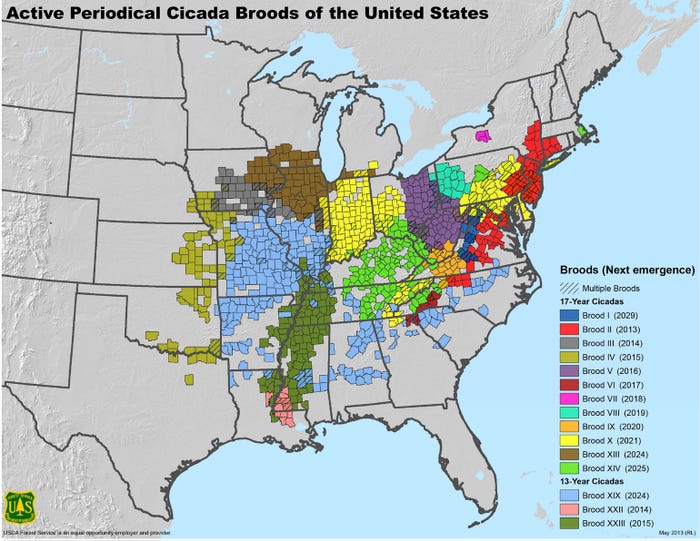July 10, 2020

We are all pretty familiar with the loud buzzing heard in late summer, caused by the annual cicada. However, depending on where you live, you may have heard a similar sound back in late May and June.
Shortly after, you may have noticed the browning of foliage at the tips of small branches and twigs on some of your larger trees, and some of those branches and twigs falling to the ground. So, what’s the difference in those two cicadas? And how can you help your plants recover?
Cicadas 101
The periodical cicada, as its name implies, emerges on a 13- or 17-year cycle. It has burnt orange wings, bright red eyes and a jet-black body, and is considerably smaller than the annual cicada. In southern regions, the cycle is 13 years, and in more northern areas, they emerge after being in the ground for 17 years. There are many broods not only in Illinois but also throughout the eastern U.S.

EMERGING: Check your county to see when the next cicada emergence may be.

This past spring, we had an early emergence of Brood XIII in northern-central Illinois and Brook XIX in southern and central Illinois. These two broods were not supposed to emerge until 2024. So why did some of them emerge in 2020?
One possible explanation is that they did not get the memo that it is only 2020, but from an entomological standpoint, we have learned it is possible for some individuals to emerge earlier than scheduled — up to one to four years, which is what may have happened this year.
Periodical cicadas spend the vast majority (13 or 17 years) of their life cycle below ground in the soil, down to about 2 feet, so it is also possible that the recent warmer winters, resulting in warmer soil temperatures, may have accelerated their development time. At their appointed time, they emerge from the soil, shed their exoskeleton skins and appear as adults.
Wounded plants
The buzzing you hear is the males and females talking to each other and is unique to each species. No listening in, please! After mating, the female cicada will use her egg-laying structure to cut slits in small branches and twigs to lay her eggs. By August, the “wounding” by the female will cause the twig or branch tip to wither and die, and in some cases, break off and fall to the ground.
This “flagging” is commonly seen after an earlier cicada emergence and is not a cause for alarm on larger trees and shrubs. Think of it as natural pruning. However, on younger plants, particularly newly planted orchard or nursery trees, the damage can be significant.
The more common annual cicada has clear wings, black and greenish markings, and a silver underbody. It is much larger than the periodical cicada. As the name implies, these cicadas come out every year, but do not cause any significant plant damage. They just remind us that summer is winding down and, yes, school is just around the corner.
If you have young plants that were damaged earlier by the periodical cicada, help them heal their wounds. Provide adequate water during dry spells, keep them mulched and eliminate competing weeds, if possible. On healthy plants, the wounds should close after one or two growing seasons, but a scar may remain. Larger trees and shrubs should be fine and will heal on their own.
For more information on the periodical cicada, consult cicadamania.com and magicicada.org.
Miller is a horticulture professor at Joliet Junior College in Joliet, Ill., and a senior research scientist in entomology at The Morton Arboretum in Lisle, Ill. Email your tree questions to him at [email protected]. The opinions of this writer are not necessarily those of Farm Progress/Informa.
About the Author(s)
You May Also Like




